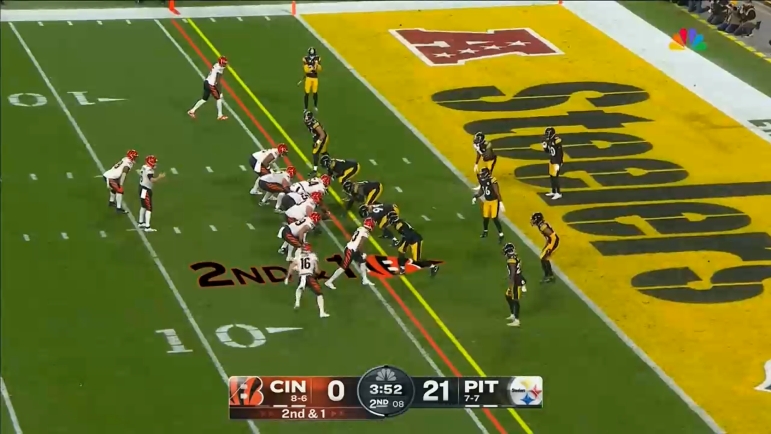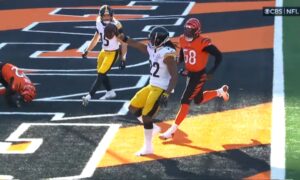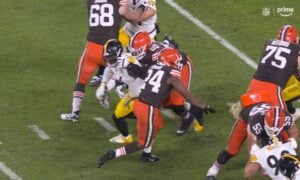It’s easy to take a new-age thought to NFL defenses, including the Pittsburgh Steelers’ world. No question, defenses and their needs have shifted compared to a decade ago. There’s more specialization, more rotation, more creativity and volume.
But there’s a prevailing wisdom that it’s a sub-package world, and we’re all living in it. Nickel and dime defenses rule the land. That’s not entirely true. If anything, we could see a shift in the other direction.
It’s something worth noting based on our final Steelers’ 2023 defensive charting. Information you won’t get anywhere else. That’s why we do it. We’ve been tracking the team’s base and sub-package rates for basically a decade. This year, the team’s base 3-4 defense was at nearly its highest point of our tracking.
According to our charting, here’s how the three main groupings were used this year.
Nickel: 37.1 percent (421 snaps)
3-4: 34.6 percent (393 snaps)
Dime: 22.0 percent (250 snaps)
Nickel still won out. But barely. Sub-package is still used the majority of the time, but more than one-third for base is nothing to sneeze at. And it was the highest rate we’ve tracked since 2015. The previous high? 39.9 percent in 2020. Base defense usage is increasing, not decreasing. Here’s the yearly rate since 2015 (and this number, to be clear, includes all packages with at least three linemen except goal line, adding in 4-4 and 3-5 fronts).
Steelers Base Defense Usage, 2015-2023:
2015: 27.4 percent
2016: 28.7 percent
2017: 38.8 percent
2018: 31.0 percent
2019: 31.3 percent
2020: 39.9 percent
2021: 35.6 percent
2022: 31.8 percent
2023: 40.3 percent
There’s ebbs and flows but it’s a general upward trend. The last time Pittsburgh ended a season in the 20’s was 2016 and the rate’s been over 35 percent in three of the last four seasons.
Much of this is responding to personnel. If offenses come out heavy, the Steelers’ defense will match and vice versa. But there are some exceptions. Pittsburgh will sometimes stay in base against three-receiver sets (13.5 percent) and sometimes play nickel against two tight end groupings (7.0 percent) depending on the game plan and skill set of the offense (teams with athletic tight ends will result in the Steelers playing more sub-package, even against 12 personnel). Offenses could be getting heavier, especially as the move to tight end becomes popular and easier to find, and defenses are responding.
What about divisional play? That’s what the Steelers think about when they build out their roster. The numbers are similar. In their six combined games against the Cincinnati Bengals, Cleveland Browns, and Baltimore Ravens, Pittsburgh played base 3-4 defense 32.3 percent of the time, a bit lower than their 34.6 season mark. A bit surprising, though consistent with our research in past years – the Steelers play base defense more outside of the division than against it. Still, it’s essentially one-third of the time.
Does game circumstance have an impact? After all, if the Steelers are trailing late, the opposing offense is more likely to be running, and Pittsburgh’s defense is more likely to be in base. Removing all fourth quarter snaps from our charting, the amount of three-down lineman usage ticks up, 41.9 percent compared to the 40.3 percent total.
All the evidence points the same way. Base defense isn’t the majority grouping, but it’s still a critical one. You need a good nose tackle and need depth behind. Pittsburgh found their starter in Keeanu Benton, though what’s behind him is unclear. Montravius Adams is quietly about to become a free agent. Don’t take it for granted.
Football is cyclical. What’s old is new. Offenses were getting smaller, faster, and the game has been more horizontal. Defenses responded in kind. Smaller and quicker defensive tackles, linebackers who looked like safeties, with a high priority on athleticism. That’s still true today, so offenses are countering back. They’re getting bigger, physical, and more downhill, especially as defenses play more two-high shells to protect the deep ball but invite the run. That’s why we’re seeing the shift. Base defense isn’t thriving, but it’s far from dead. This shift towards it might only continue.








